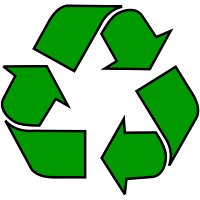Guest Column – Where is Your Trash Going?
WHERE IS YOUR TRASH GOING?
Do you know where your trash is going? In order to answer this question you need to know where the process starts. In your house you have a certain schedule for your garbage. All schedules help ‘get rid’ of your trash. Before you can permanently get rid of your garbage you have a way to temporarily dispose of it. Some homes have an inside bin for their trash and an outside moveable dumpster/trash can. When your garbage bag gets full, you take it outside to your dumpster/ trash can and it gets picked up. When trash day comes a garbage truck empties those containers. The trash is now gone for good, right? No.
The trash is going to a transfer station. This is where the garbage trucks temporarily unload the cargo. While it is there it is compacted, firmly packed together and is ready for its next destination. It is loaded into a bigger truck and moved to Material Recovery Facility (MRF). Here it sorted to recover any useful materials. They use magnets to pick up any metals. They also, use shredders and current separators to separate the non-ferrous and the ferrous metals. Ferrous metals include different steels or irons. They are used for their tensile strength and are common. Non Ferrous metals are made of aluminum, zinc, gold, etc. It is much lighter, and has aluminum which is the third most recycled metal. After it is sorted, it goes to its final location; landfills, waste-to-energy plants, or composters. The most popular destination is a landfill.
Over 52% of our trash gets dumped at one of the 3,000 active landfills scattered across the U.S. They are covered in clay and plastic and have drains at the bottom to get rid of the liquids the garbage makes. They are decided to only hold waste and not to break it down. Eventually a level will get full. When this happens another layer of plastic is put on top then, soil and plants. The composting is slower now, because it has no or very little oxygen.
Recycling plants and composters take old materials and make them into new materials. Recycling plants mainly focus on processing the materials. Composters take food and agricultural waste and turn it into compost. They sell it for municipal and customer use. Thirty percent of waste is transferred here.
Waste-to-energy-plants (trash incinerators) are large industrial furnaces which burns waste. It operates at 1,800 degrees Fahrenheit. This reduces volume of waste by 95%. More than 9% or garbage goes here. Hopefully you have learned and now see how the environment is used for our trash.
Editor's note: We usually don't accept guest columns – confirming the true ownership of an article can take some time. That said, we did a little homework and this does appear to be the original work of Allissa, a local 4-H member. We post it unedited. Promote 4H efforts – Please like it and share it on social media. More about 4-H here.
